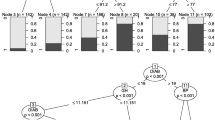Abstract
Relying on an ordinal relationship among class labels, ordinal classifiers incorporate semantic knowledge about the classes into a purely data-driven multi-class classification task. Under the assumption that this relationship is reflected in feature space, these classifiers organize their internals according to this information. One essential step required is the identification of the true inter-class dependencies.
In this work, we now focus on the ability of cascaded ensemble classifiers to detect the relationships among ordinal classes. The minimal class sensitivity proves to be suitable to quantify this ability. This is an important problem, as for instance in medical applications often the true ordering of the classes is unknown or only partly known. We show that we can detect the ordinal class structure or its absence and that this ability depends on both the chosen base classifiers and the corresponding training schemes.
R. Lattke and L. Lausser—Contributed equally.
Access this chapter
Tax calculation will be finalised at checkout
Purchases are for personal use only
Similar content being viewed by others
References
Bache, K., Lichman, M.: UCI machine learning repository (2013). http://archive.ics.uci.edu/ml
Ben David, A.: Dataset: Ordinal real-world datasets (esl, lev, swd). Irvine, CA.: University of California, School of Information and Computer Science (2008). http://archive.ics.uci.edu/ml
Bishop, C.: Pattern Recognition and Machine Learning. Springer, New York (2006)
Breiman, L., Friedman, J.H., Olshen, R.A., Stone, C.J.: Classification and Regression Trees. Wadsworth Publishing Company, Belmont (1984)
Cardoso, J., Pinto da Costa, J.: Learning to classify ordinal data: the data replication method. J. Mach. Learn. Res. 8, 1393–1429 (2007)
Fix, E., Hodges, J.L.: Discriminatory analysis: Nonparametric discrimination: Consistency properties. Technical report. Project 21–49-004, Report Number 4, USAF School of Aviation Medicine, Randolf Field, Texas (1951)
Frank, E., Hall, M.: A simple approach to ordinal classification. In: Flach, P.A., De Raedt, L. (eds.) ECML 2001. LNCS (LNAI), vol. 2167, pp. 145–156. Springer, Heidelberg (2001)
Hühn, J., Hüllermeier, E.: Is an ordinal class structure useful in classifier learning? J. Data Min. Model. Manage. 1(1), 45–67 (2009)
Lorena, A., de Carvalho, A., Gama, J.: A review on the combination of binary classifiers in multiclass problems. Artif. Intell. Rev. 30, 19–37 (2008)
Müssel, C., Lausser, L., Maucher, M., Kestler, H.A.: Multi-objective parameter selection for classifiers. J. Stat. Softw. 46(5), 1–27 (2012)
Platt, J.C., Shawe-Taylor, J., Cristianini, N.: Large margin dag’s for multiclass classification. In: Proceedings of Advances in Neural Information Processing Systems 12, January 1999
Rivest, R.L.: Learning decision lists. Mach. Learn. 2(3), 229–246 (1987)
Sammut, C., Webb, G.: Encyclopedia of Machine Learning. Springer, New York (2010)
Tax, D., Duin, R.: Using two-class classifiers for multiclass classification. In: International Conference on Pattern Recognition (2002)
Vapnik, V.: Statistical Learning Theory. Wiley, New York (1998)
Acknowledgements
The research leading to these results has received funding from the European Community’s Seventh Framework Programme (FP7/20072013) under grant agreement n\(^\circ \)602783 (to HAK), the German Research Foundation (DFG, SFB 1074 project Z1 to HAK), and the Federal Ministry of Education and Research (BMBF, Gerontosys II, Forschungskern SyStaR, project ID 0315894A to HAK).
Author information
Authors and Affiliations
Corresponding author
Editor information
Editors and Affiliations
Rights and permissions
Copyright information
© 2015 Springer International Publishing Switzerland
About this paper
Cite this paper
Lattke, R., Lausser, L., Müssel, C., Kestler, H.A. (2015). Detecting Ordinal Class Structures. In: Schwenker, F., Roli, F., Kittler, J. (eds) Multiple Classifier Systems. MCS 2015. Lecture Notes in Computer Science(), vol 9132. Springer, Cham. https://doi.org/10.1007/978-3-319-20248-8_9
Download citation
DOI: https://doi.org/10.1007/978-3-319-20248-8_9
Published:
Publisher Name: Springer, Cham
Print ISBN: 978-3-319-20247-1
Online ISBN: 978-3-319-20248-8
eBook Packages: Computer ScienceComputer Science (R0)




